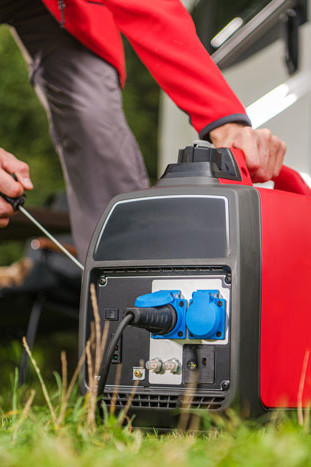Flipping a light switch. Plugging in a coffeemaker. Charging a laptop computer. These are second nature for most of us. Electricity makes our lives easier. However, we need to be cautious and keep safety in mind.
Electrical Safety Tips
- Have all electrical work done by a qualified electrician.
- When you are buying or remodeling a home, have it inspected by a qualified private inspector or in accordance with local requirements.
- Only use one heat-producing appliance (such as a coffee maker, toaster, space heater, etc.) plugged into a receptacle outlet at a time.
- Major appliances (refrigerators, dryers, washers, stoves, air conditioners, microwave ovens, etc.) should be plugged directly into a wall receptacle outlet. Extension cords and plug strips should not be used.
- Arc-fault circuit interrupters (AFCIs) shut off electricity when a dangerous condition occurs. Consider having them installed in your home.
- Use ground-fault circuit interrupters (GFCIs) to reduce the risk of shock. GFCIs shut off an electrical circuit when it becomes a shock hazard. They should be installed inside the home in bathrooms, kitchens, garages and basements. All outdoor receptacles should be GFCI protected.
- Test AFCIs and GFCIs once a month according to the manufacturer’s recommendations. You do not need a flame to start a fire. Fires can start when heat builds up near things that burn. This can happen when a hot light bulb is near things that burn, such as cloth or paper, or a cord has been placed under a carpet. Check electrical cords to make sure they are not running across doorways or under carpets. Extension cords are intended for temporary use. Have a qualified electrician add more receptacle outlets so you don’t have to use extension cords.
- Use a light bulb with the right number of watts. There should be a sticker that indicates the right number of watts.
Fact
A person can be poisoned by a small amount of CO over a longer period of time or by a large amount of CO over a shorter amount of time.
Important Reminder
Call a qualified electrician or your landlord if you have:
- Frequent problems with blowing fuses or tripping circuit breakers
- A tingling feeling when you touch an electrical appliance
- Discolored or warm wall outlets
- A burning or rubbery smell coming from an appliance
- Flickering or dimming lights
- Sparks from an outlet
Generator Safety
Downed utility lines, power company blackouts, heavy snow falls or summer storms can all lead to power outages. Many people turn to a portable generator for a temporary solution without knowing the risks.
- Generators should be used in well ventilated locations outside at least 5 feet (1.5 metres) away from all doors, windows, and vent openings. Measure the 5-foot (1.5 metres) distance from the generator exhaust system to the building.
- Never use a generator in an attached garage, even with the door open.
- Place generators so that exhaust fumes can’t enter the home through windows, doors or other openings in the building. The exhaust must be directed away from the building.
- Make sure to install carbon monoxide (CO) alarms in your home. Follow manufacturer’s instructions for correct placement and mounting height.
- Turn off generators and let them cool down before refueling. Never refuel a generator while it is hot.
Just Remember…
When plugging in appliances, make sure they are plugged directly into the generator or a heavy duty outdoor-rated extension cord. The cords should be checked for cuts, tears and that the plug has all three prongs, especially a grounding pin. If you must connect the generator to the house wiring to power appliances, have a qualified electrician install a properly rated transfer switch in accordance with the National Electrical Code® (NEC) and all applicable state and local electrical codes.
